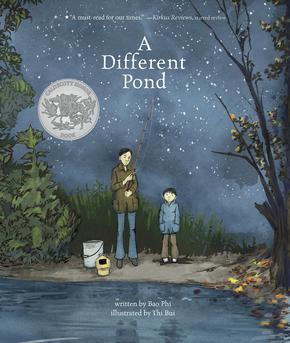A Different Pond facts for kids

Cover of the picture book
|
|
| Author | Bao Phi |
|---|---|
| Illustrator | Thi Bui |
| Country | United States |
| Language | English |
| Genre | Children's |
| Publisher | Capstone Publishers |
|
Publication date
|
August 1, 2017 |
A Different Pond is a special picture book from 2017. It was written by Bao Phi and beautifully illustrated by Thi Bui. The story is about a boy and his father who go fishing early in the morning.
Bao Phi wrote this book because he wanted more stories that showed people like his own family for his daughter to read. Thi Bui's detailed drawings were so powerful that Phi even removed some of his writing. Bui had never illustrated a traditional picture book before. She won a 2018 Caldecott Honor for her amazing use of colors. The book was highly praised and appeared on many "best of 2017" book lists.
Contents
What the Story is About
The book tells the story of a young boy and his father. They wake up very early on a Saturday morning to go fishing. The father came to the United States after a war in his home country.
Catching fish is important for their family. It helps them have enough food to eat. After they catch a fish, they go back home. The father then has to go to work. The boy knows that the fish they caught will be dinner that night. It's a story about family, hard work, and love.
How the Book Was Made
Why Bao Phi Wrote It
Author Bao Phi really wanted to see more diverse books. He wanted stories that reflected different backgrounds for his daughter. He decided to turn an old poem of his into a children's picture book. He felt there weren't many picture books about the experiences of families from Southeast Asia who came to America.
A company called Capstone Publishers saw a blog post Phi wrote. They asked him if he had a children's book idea. That's when he shared the story for A Different Pond.
Thi Bui's Illustrations
When Bao Phi saw Thi Bui's drawings, he was amazed. He felt her pictures told so much of the story. He even decided to take out some of his words because the art was so strong.
Thi Bui was very excited to illustrate the book. She felt a connection to the story because her own family had a similar journey. She even asked Phi about his childhood memories. This helped her make the illustrations feel real.
Bui had never drawn for a picture book before. She also hadn't drawn in full color for a project like this. She worked hard to make sure every detail was perfect. The book was published on August 1, 2017.
The Story and Its Art
A Universal Story
Even though A Different Pond is about a specific family from Southeast Asia, its themes are universal. It's about family, hard work, and making a new life. The father's past, including a war he doesn't talk about, is a quiet but strong part of the story.
The family's financial situation is also shown. For example, the father and son eat a simple bologna sandwich while fishing. The boy wonders why they need to catch fish when his father works two jobs. These details show how hard the family works. The father is shown as a wonderful parent. He works hard to give his son a better life. He guides and loves his son, helping him grow up.
How Words and Pictures Work Together
Some might think the story sounds sad, but the way the words and pictures combine makes it feel gentle. Thi Bui's background in drawing cartoons and graphic novels helped her capture the mood. She uses frames in her art. This helps keep the story focused on the present moment. It also shows flashes of the past.
Bui's use of colors is also praised. She uses a lot of blues. She contrasts them with bright reds and oranges. The cover illustration is also very special. It draws readers in and perfectly captures the heart of the story.

